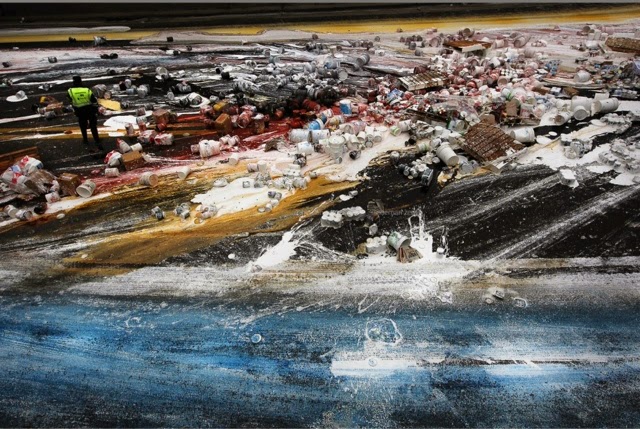Wednesday, December 17, 2014
Robert Capa
Paul Fusco
Paul Fusco photographs documented social issues , injustices such as poverty and ghetto life. In 1968 Kennedy's body was taken to New York City for a memorial service at St. Patrick’s Cathedral . It was carried by a train from New York to Washington D.C. for burial at Arlington National Cemetery. Thousands of mourners lined the railway tracks to pay their respects to Kennedy. Paul Fusco from the inside the train took around 2000 pictures of the mourners black, white, rich, poor, in large groups. These photographs captured a crucial moment in U.S. history. His images are one of the most powerful and affecting for me .
Paul Fusco has become very successful in his job. He doesn't only do it for him self but he also does it for the world thAts around him. He wants to capture moments that people could see . Paul Fusco started at a young age and he has gotten very affecting photo graphs that tells a story. He's been in dangerous situations but he has accomplish his mission. Each photo of him tells it's own story And carries it's own weight.
Kevin Carter
Louie Palu - Jess Duran
Louie Palu Was so fascinated by war in a beautiful way. He felt he had to uncover and expose these harsh realities that are an everyday part of life. His images were disturbing but you can't look away because it gives you so much to feel. He covered war in Afghanistan
For 5 years. He experienced very real things such as losing friends in the same squad as him.
While he was in Afghanistan , he liked to take portraits of people's faces. Different soldiers with different facial expressions but in a way they all connect and share a feeling of human decency.
Palu Believed That it was his role in the world to monitor and owe and document Social political issues, human rights, poverty, and conflict. He did it so well he won an award for best documentary photographer featuring his very famous photographic documentary . He captured a lot of murders and the struggles of living during a war.
Palus most recent work is mostly covering the Mexico Drug War. About 50,000 People dead in just 6 years and Palu Covered a lot of it. His work was mostly along the border in Cuidad Juarez, Mexico. He covered Drug related bloody crisis. He also journeyed into the Key Cartel territory and government controlled areas. One photograph in specific were he takes a picture of cameras to remember his fallen comrades and fellow photojournalists who have devoted and given their life's to expose the truth about the world.
All In All, Louie Palu Is An inspiration amongst other professional photographers around the world capturing the truth through intense, dramatic ,and disturbing photographs . His work is shown throughout the world not to mention a museum of his own. He continuous to devote his life to photography and continues to document the harsh challenges people living in poverty and government corruption.
- http://louiepalu.photoshelter.com/gallery-image/Mira-Mexico/G00000HwIP1Korg8/I0000B0pnuHqxusA
- http://www.theatlantic.com/infocus/2012/05/mexicos-drug-war-50-000-dead-in-6-years/100299/
- http://en.m.wikipedia.org/wiki/Louie_Palu
James nachtwey
James Nachtwey.
There is one photojournalism that really popular. His name is James Nachtwey is an American photojournalism and war photographer. He went to many countries; he had took a lot different type of photo not just war pictures. James Nachtwey best known for his work documentary wars, civil strife and other social international. James Nachtwey is one of the popular photojournalism now day that still alive.
James Nachtwey he born on March 14, 1948 and grew up in Massachusetts and graduated from Dartmouth College, where studies Art history and Political science. During this time there are few images from the Vietnam War and American Civil Rights movement a powerful effect on him and were lead him to become a photographer. He was worked aboard ships in the Merchant Marine, and while teaching himself photography, he was and apprentice news film editor and a truck driver.
His career started as a newspaper photographer in 1976 at the Albuquerque journal in Mexico. In 1980 he moved to New York to begin a career as a freelance magazine photographer. His first foreign assignment was to cover Civil Strife in Northern Ireland in 1981 during the IRA hanger strike. After he got this assignment he decides to document wars, conflicts and social issues.
After 3 years of hard works, discover many countries and been thought all the social issues around him. In 1984 he has been a contract as a photographer with Time Magazine. In 2001, he becomes one of the founding members of the photo agency VII (he disassociated from VII in August 2011). He has received a lot different honors reward like Robert Capa Gold Medal and more.
Right now he lives in New York City with the rest of his live. To me he is one of the best photojournalism in United States. What he had done with amazing photos he took that tell the stories that other people dint get a chance to share to the world. I am respect his decisions after saw the war picture and decides to become a photojournalism.
3 sources
http://www.biography.com/people/james-nachtwey-38952#synopsis















































